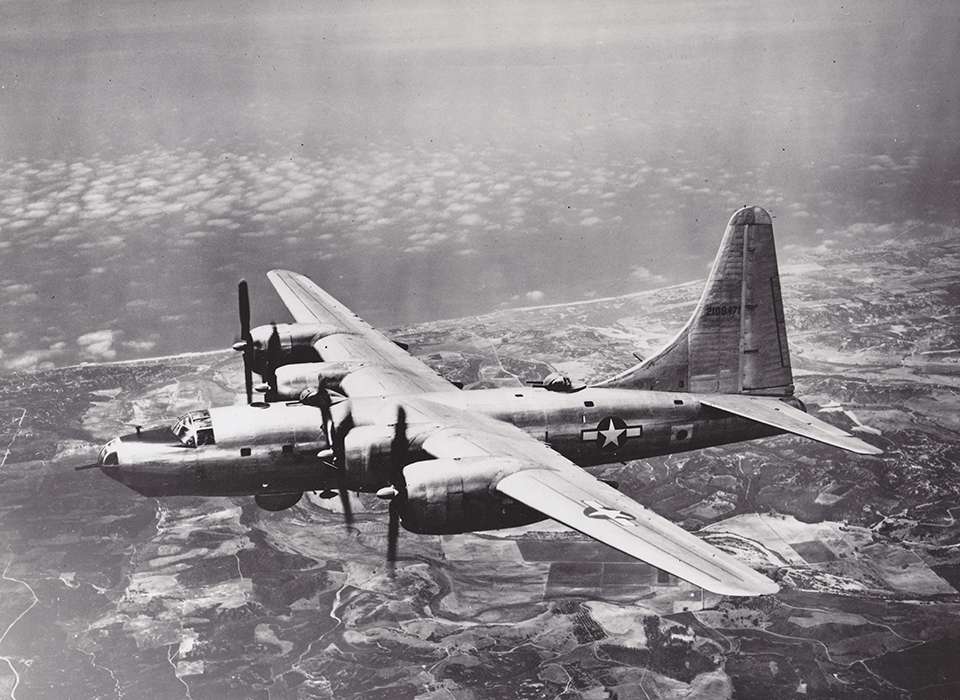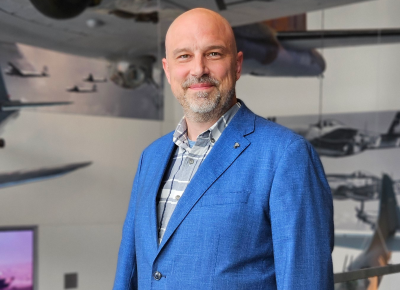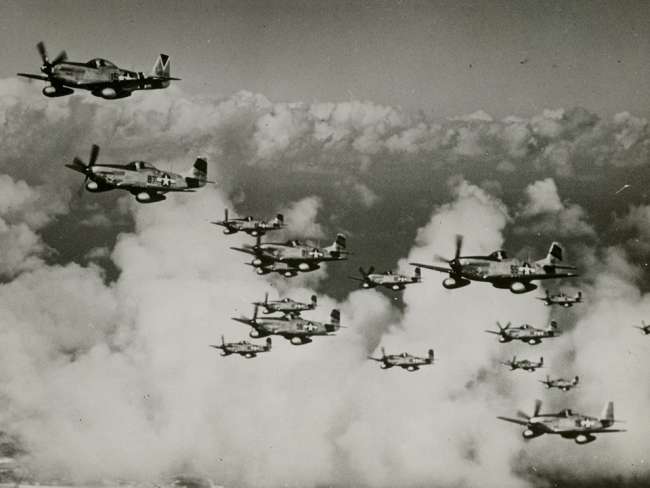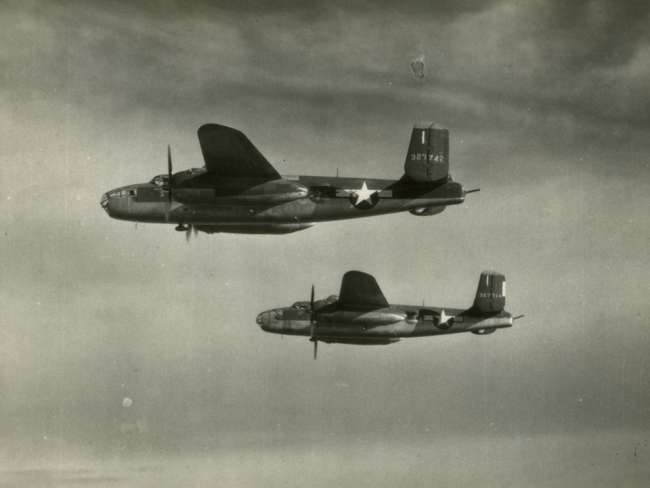Top image courtesy of the National Archives.
Before the Boeing B-29 Superfortress became the linchpin to victory in the Pacific, it was a troublesome mess. The “superbomber” was incredibly advanced and, as a result, it was more complex than any other aircraft in history. As Boeing rushed to get the mammoth machine ready for service, a multitude of minor and major technical issues cropped up, including catastrophic engine cooling problems that led to the loss of a prototype aircraft in a fiery accident in early 1943.
Rarely willing to put all of its eggs in one basket, the US Army Air Forces had a back-up plan in the event that Boeing’s developers, suppliers, or builders ultimately crashed and burned. As early as 1940, military officials consulted with Consolidated Aircraft Corporation and commissioned the company to design and build an aircraft similar to the vexing B-29.
Parallel aircraft development programs were common as America geared up for a fight, often leading to a pair of similar and successful warplanes. North American’s famous B-25 Mitchell and Martin’s speedy B-26 Marauder were born from the same 1939 medium bomber proposal. When the Vought F4U Corsair naval fighter ran into difficulties qualifying for carrier operations, Grumman’s Hellcat briefly took center stage alone as the Navy’s most capable front-line fighter. With the Corsair modified for carrier duty, the last year of the war saw both aircraft types prowling the Pacific in great numbers. In the skies over Occupied Europe, the Boeing’s venerable B-17 Flying Fortress was joined by the newer, but in many ways analogous, Consolidated B-24 Liberator.
Now Consolidated and Boeing were going head-to-head again, racing to develop a streamlined, massive, and fully-pressurized “very heavy” bomber that could reach deep into Germany, or even hit Tokyo.
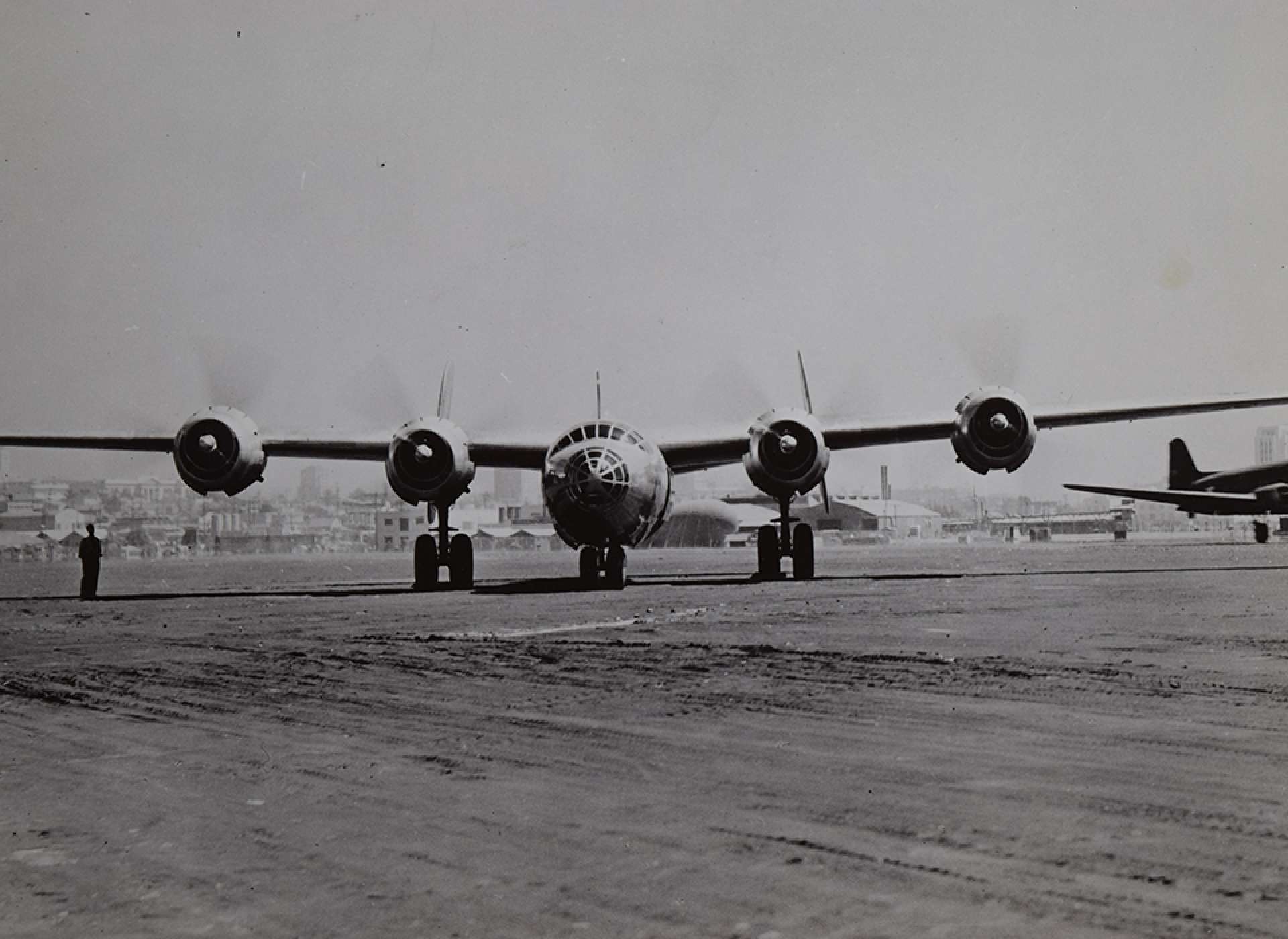
The twin-tailed prototype XB-32 lines up for a test flight over San Diego circa 1943. The aircraft type would go through many design changes before it was ready for combat. Courtesy National Archives.
To most observers, Consolidated’s creation was not an attractive-looking aircraft. Officially designated the XB-32, the prototype mega-bomber borrowed the efficient Davis airfoil wing and distinctive double tail of the layout of the earlier B-24 Liberator. Its chubby, cigar-shaped fuselage sported a multi-paned “birdcage” nose and flight deck that looked decidedly antiquated. Later versions of the bomber that would become known as the Dominator flew with a host of improvements including revised defensive weaponry, more modern nose and cockpit glass, and a strikingly tall single vertical tail.
Both the B-29 and B-32 used Wright’s powerful but persnickety R-3350 Duplex-Cyclone 18-cylinder radial engines, driving four large four-bladed propellers. Both were fully-pressurized, could carry up to 20,000 pounds of bombs, and maxed out at around 357 miles per hour. The B-32 was slightly smaller, a bit faster at normal cruising speed, and could fly farther.
For a time, both the government and Consolidated banked on building thousands of Dominators for combat. But as the war progressed through 1943 and into 1944, it became increasingly clear that Boeing and the US Army Air Forces were solving, or at least working their way through, many of the B-29’s most alarming issues.And as might be expected for a plane that was similar in size and mission, the B-32 Dominator was saddled with its own set of thorny troubles during development and beyond, including unreliable pressurization, faulty landing gear, and the same engine issues that plagued the B-29.
Though meant as a reliable back-up, the development of the B-32 slowed to a crawl, mired in problems. Ultimately, 118 Dominators were built. During roughly the same time span, five aircraft plants turned out nearly 4,000 B-29s.
Only a handful of B-32 Dominators made it into combat. One for the first trio of aircraft sent to the Pacific was aircraft serial number 42-108532, nicknamed Hobo Queen II. The first B-32s assigned to the 386th Bombardment Squadron (Heavy) underwent initial combat evaluation in the Philippines, attacking targets in Formosa.
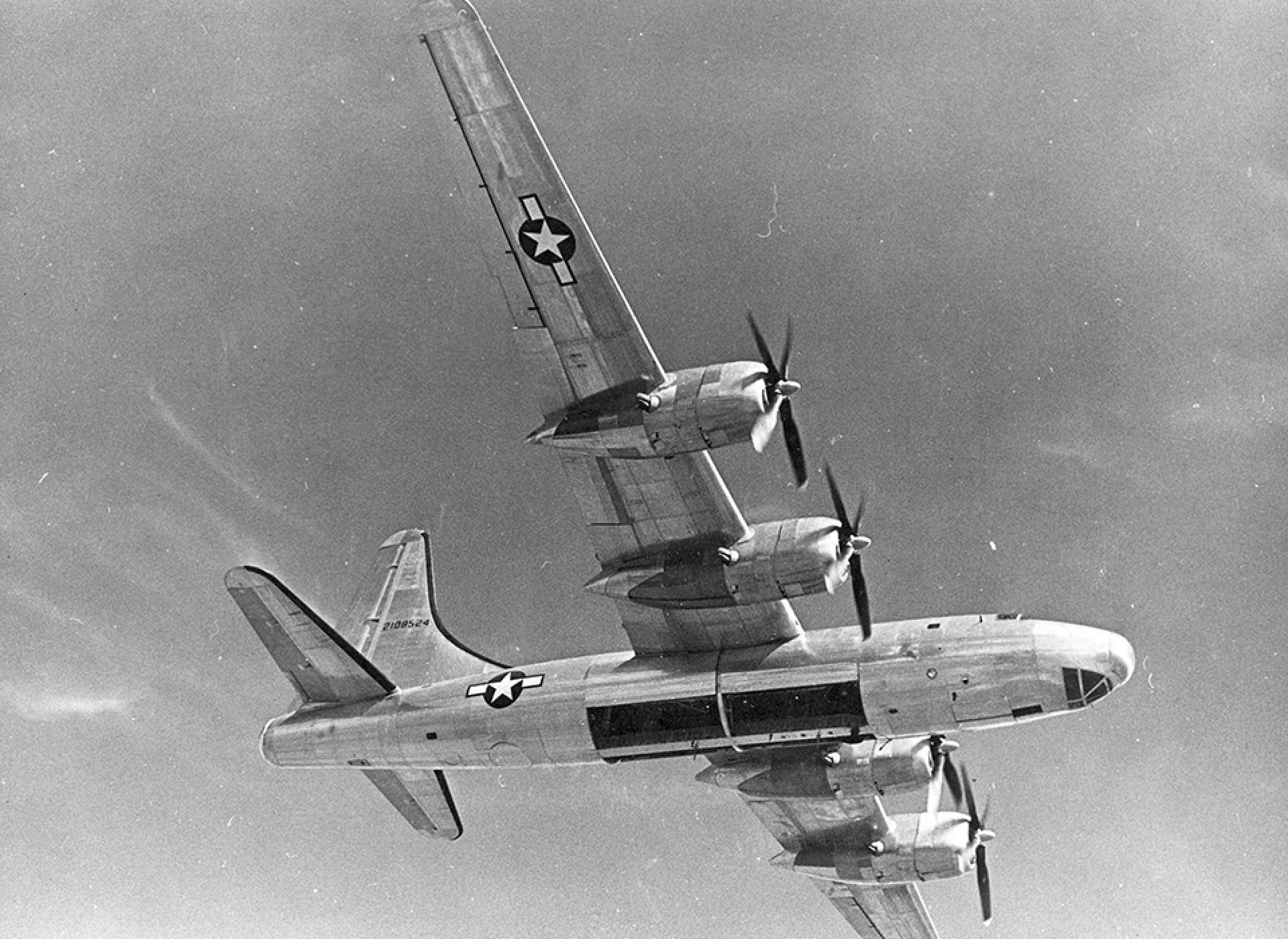
Though built to haul 20,000 pounds of bombs in expansive twin bomb bays, most late-war B-32 missions involved shooting high-altitude reconnaissance photos over the Empire of Japan. Courtesy National Archives.
As more B-32s arrived and the war closed in around Japan, the 386th moved forward to Okinawa. By this time, deep into the summer of 1945, Dominators often worked in small groups conducting ocean search missions or flying over the Japanese home islands to conduct photographic reconnaissance.
As the events that would bring the Pacific war to a close rolled by, the recon missions assigned to the 386th continued without pause. B-32s flew sorties to Japan beyond the August 6 atomic bomb attack on Hiroshima, the August 9 follow-up at Nagasaki, and even kept flying after Japan’s acceptance to the terms of surrender and ceasefire on August 15. In fact, America’s need for quality images, unhindered by the danger of enemy flak and fighters, actually grew as the shooting subsided. Photos taken by Dominators aided in locating POW camps, assisted in the planning of Allied occupation operations, and helped keep an eye out for suspicious activity at Japanese airfields and ports.
On August 17, almost 48 hours after the cessation of hostilities between the United States and Japan, B-32s on a photo run near Tokyo encountered rogue Japanese fighters. Dragged into an hours-long running gun battle, the alarmed crews of the photo ships expended around 4,000 rounds of ammunition in the direction of the marauding fighters. All four B-32s returned safely, though with a few extra holes in their airframes.
On the morning of August 18, 1945, it was the assignment of Hobo Queen II and another B-32 to follow a similar path, snooping Japanese airfields and investigating to ascertain whether the skirmish from the day before was an isolated incident. They were on their last photo runs over Yokosuka when the crewmen observed Japanese aircraft boring in. Roughly 14 Mitsubishi A6M and Kawanishi N1K fighters attacked the pair of Dominators from the front and sides, making aggressive passes on the American aircraft while gunners threw out a curtain of .50-caliber defensive fire. Gunners from Hobo Queen II reported the destruction of two enemy fighters in the melee—possibly the last shoot-downs of the war.
The other B-32 in the formation, piloted by First Lieutenant John R. Anderson, weathered the worst of many shattering bursts of gunfire that damaged both its number three engine and rudder trim tabs, as well as smashed several windows. When a 20mm shell slammed into the aircraft near his station, gunner Sergeant Jimmy Smart was hit in the head and sprayed with fragments and shattered Plexiglas. As he was stowing his camera equipment, photographer Staff Sergeant Joseph Lacharite was struck in the legs by gunfire. Soon after, a Japanese 20mm round passed through the Dominator’s fuselage and struck Sergeant Anthony Marchione with terrible force as he assisted Lacharite.
As the B-32s dove away from Japan and outdistanced their attackers, the urgent race to save Lacharite and Marcoine’s lives began.
Lancharite held on, though it would take years for him to fully recover from his wounds. Nineteen-year-old Anthony Marchione, however, died in his aircraft during the return flight to Okinawa. Marchione has the sorrowful distinction of being the last man to be killed in what would be the last air combat of World War II.
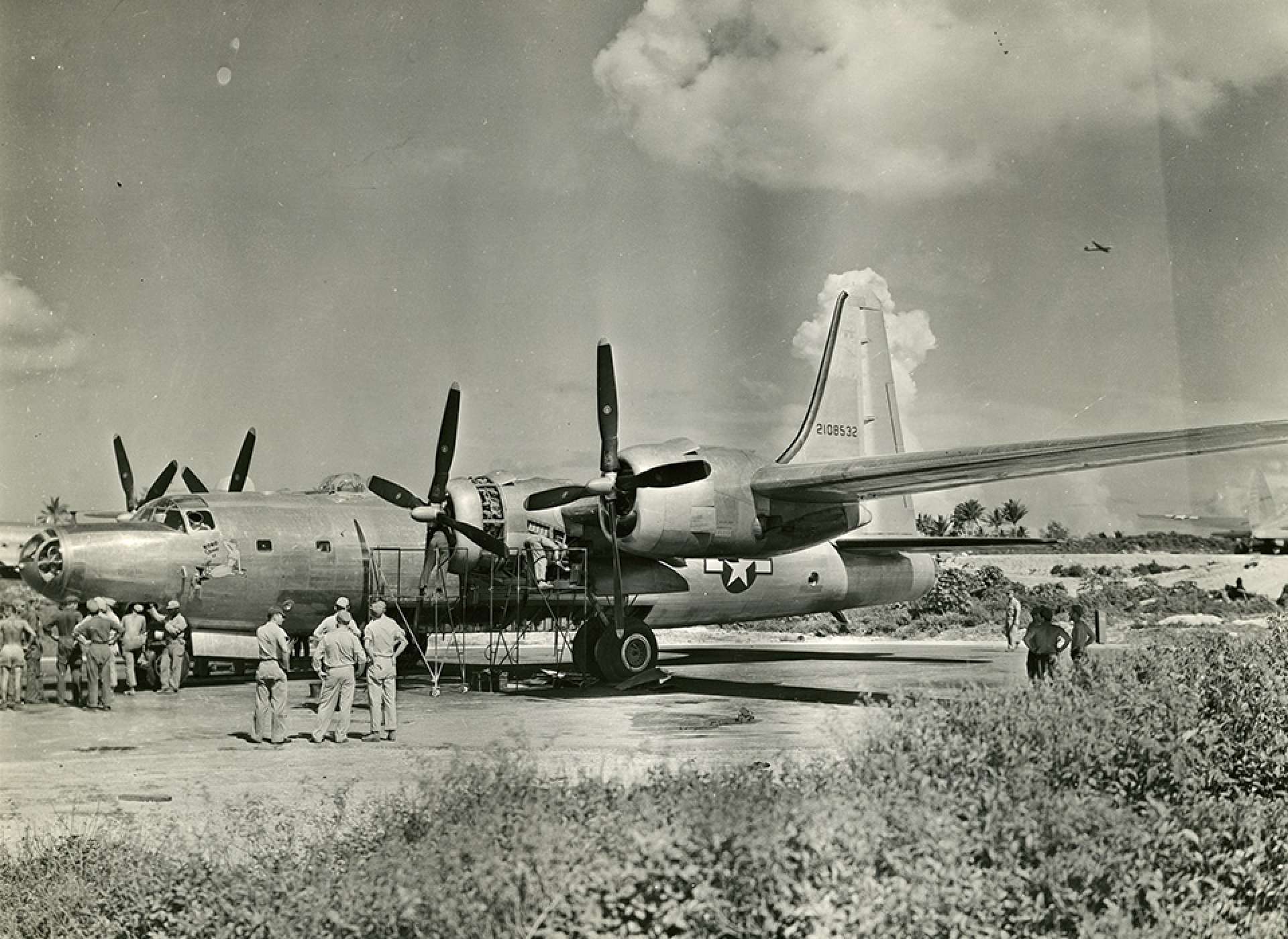
Hobo Queen II photographed undergoing maintenance on the island of Tinian in 1945. The National WWII Museum, Gift in Memory “Ham” Hamilton, 2010.216.364.
Though the Consolidated B-32 Dominators had only a few months of service and logged just a few dozen combat hours in the air, the US Army Air Forces began to strike the aircraft from their inventories soon after the war ended. The machines soon went into storage and then were unceremoniously chopped to pieces.
A few failed to make it that far. Days after Japan’s formal surrender aboard the USS Missouri, Hobo Queen II’s landing gear retracted while it was parked on an Okinawa airstrip. The accident, caused by a careless ground crewman, crushed the bomber’s nose. In attempts to lift the plane, a crane operator dropped the aircraft twice more, further damaging the airframe. A few months later, there was nothing left of Hobo Queen II but a memory of its name and a handful of photos.
Cite this article:
MLA Citation:
APA Citation:
Chicago Style Citation:
